This content has been machine translated dynamically.
Dieser Inhalt ist eine maschinelle Übersetzung, die dynamisch erstellt wurde. (Haftungsausschluss)
Cet article a été traduit automatiquement de manière dynamique. (Clause de non responsabilité)
Este artículo lo ha traducido una máquina de forma dinámica. (Aviso legal)
此内容已经过机器动态翻译。 放弃
このコンテンツは動的に機械翻訳されています。免責事項
이 콘텐츠는 동적으로 기계 번역되었습니다. 책임 부인
Este texto foi traduzido automaticamente. (Aviso legal)
Questo contenuto è stato tradotto dinamicamente con traduzione automatica.(Esclusione di responsabilità))
This article has been machine translated.
Dieser Artikel wurde maschinell übersetzt. (Haftungsausschluss)
Ce article a été traduit automatiquement. (Clause de non responsabilité)
Este artículo ha sido traducido automáticamente. (Aviso legal)
この記事は機械翻訳されています.免責事項
이 기사는 기계 번역되었습니다.책임 부인
Este artigo foi traduzido automaticamente.(Aviso legal)
这篇文章已经过机器翻译.放弃
Questo articolo è stato tradotto automaticamente.(Esclusione di responsabilità))
Translation failed!
多类型许可
多类型许可支持在单个 Citrix Virtual Apps and Desktops 站点上为交付组使用不同的许可证类型。类型是产品 ID(XDT 或 MPS)和模式(UserDevice 或 Concurrent)的一种组合。交付组必须使用在站点级别配置的相同产品版本(PLT/Premium 或 ENT/Advanced)。希望为 Citrix Virtual Apps and Desktops 部署配置多类型许可时,请注意本文末尾的特殊注意事项。
如果未配置多类型许可,则仅当为独立站点配置时才能使用不同的许可证类型。交付组使用站点许可证。有关配置多类型许可时的重要通知限制,请参阅特殊注意事项。
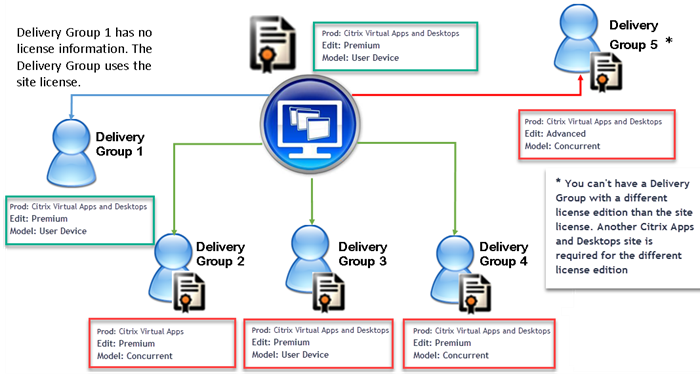
要确定使用不同许可证类型的交付组,请使用以下 Broker PowerShell cmdlet:
- New-BrokerDesktopGroup
- Set-BrokerDesktopGroup
- Get-BrokerDesktopGroup
要安装许可证,请使用:
- Citrix Studio
- Citrix Licensing Manager
- citrix.com
Customer Success Services 日期是每个许可证文件以及每个产品和模式特有的。以不同方式设置的交付组的 Customer Success Services 日期可能会不同。
特殊注意事项
多类型许可与常规 Citrix Virtual Apps and Desktops 许可的功能不同。
对于配置为使用与站点配置不同的类型的交付组,Director 或 Studio 没有发出警报和通知:
- 接近许可证限制或许可证突发模式的触发或到期时没有任何信息。
- 特定组出现问题时不显示任何通知。
为多类型许可证配置的交付组仅使用该许可证类型,在完全使用时不会回退到站点配置。
尽管 Citrix Virtual Apps Standard 和 Citrix Virtual Desktops Standard 许可证版本名称只是这些许可证都是 Standard 版本,但其版本不同。多类型许可不适用于 Citrix Virtual Apps Standard 和 Citrix Virtual Desktop Standard 许可证。
许可证兼容性列表
此表详细介绍了旧产品名称、新产品名称和关联的功能名称。四个兼容性列指定了哪些产品和许可模式组合适用于多类型许可。CCU 和 CCS 表示并发许可证,UD 表示用户/设备许可证。
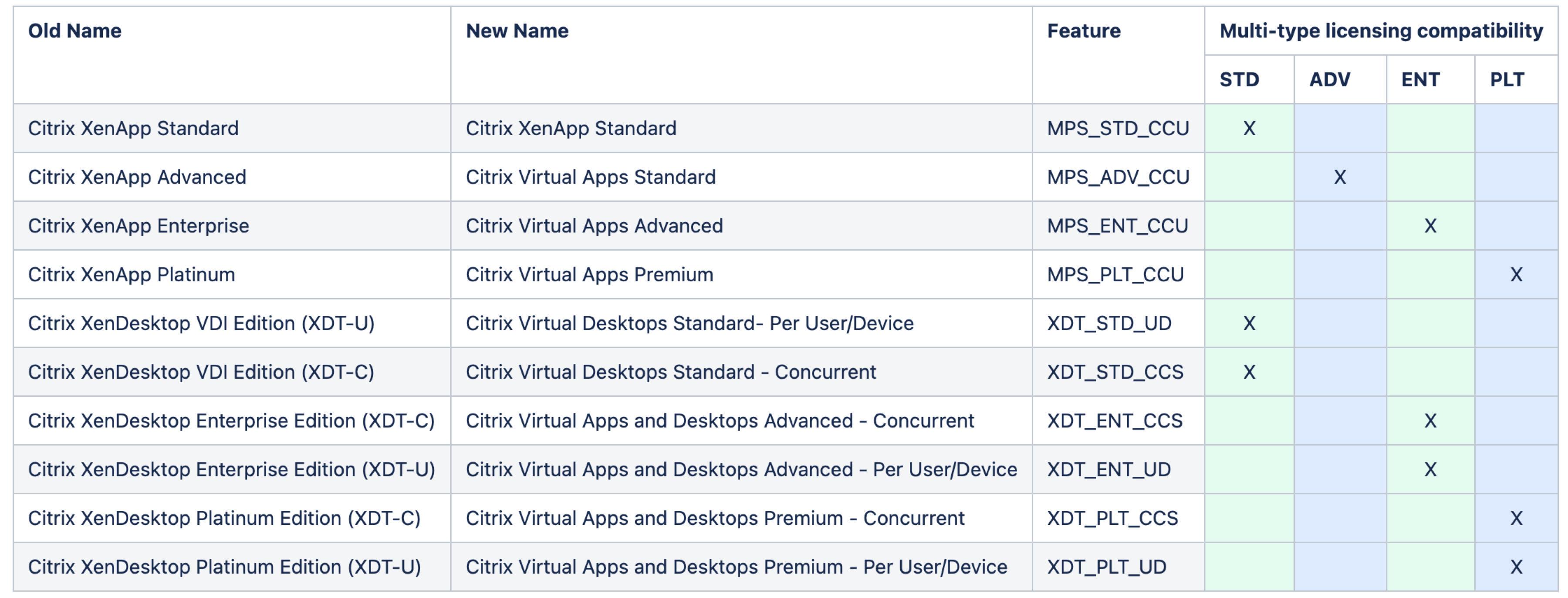
Broker PowerShell SDK
DesktopGroup 对象具有以下两个属性,您可以使用关联的 New-BrokerDesktopGroup 和 Set-BrokerDesktopGroup cmdlet 进行控制。
| 名称 | 值 | 限制 |
|---|---|---|
| LicenseModel | 用于指定组的许可模式的参数(Concurrent 或 UserDevice)。如果未指定,则使用站点范围的许可模式。 | 如果禁用功能切换,尝试设置属性将失败。 |
| ProductCode | 指定组的许可产品 ID 的文本字符串 XDT(表示 Citrix Virtual Desktops)或 MPS(表示 Citrix Virtual Apps)。如果未指定,则使用站点范围的产品代码。 | 如果禁用功能切换,尝试设置属性将失败。 |
有关LicenseModel 和 ProductCode 的详细信息,请参阅 about_Broker_Licensing。
New-BrokerDesktopGroup
创建桌面组以便对多组桌面的代理进行管理。有关此 cmdlet 的详细信息,请参阅https://citrix.github.io/delivery-controller-sdk/Broker/New-BrokerDesktopGroup/。
Set-BrokerDesktopGroup
禁用或启用现有 Broker 桌面组或更改其设置。有关此 cmdlet 的详细信息,请参阅 https://citrix.github.io/delivery-controller-sdk/Broker/Set-BrokerDesktopGroup/
Get-BrokerDesktopGroup
检索匹配指定条件的桌面组。Get-BrokerDesktopGroup cmdlet 的输出包括组的 ProductCode 和 LicenseModel 属性。如果未使用 New-BrokerDesktopGroup 或 Set-BrokerDesktopGroup 设置这些属性,则返回空值。如果为空,则使用站点范围的许可模式和产品代码。有关此 cmdlet 的详细信息,请参阅https://citrix.github.io/delivery-controller-sdk/Broker/Get-BrokerDesktopGroup/。
按照交付组配置不同的许可证产品和型号
- 使用管理权限打开 PowerShell 并添加 Citrix 管理单元。
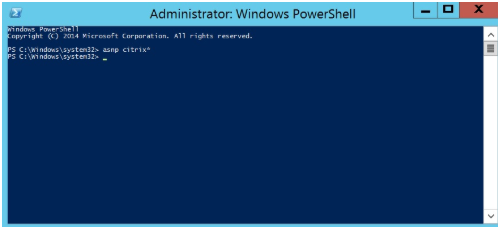
-
运行命令 Get-BrokerDesktopGroup –Name “DeliveryGroupName” 以查看当前许可证配置。查找 LicenseModel 和 ProductCode 参数。如果以前未配置过以下参数,则它们可能为空。
注意:
如果交付组未设置许可证信息,则默认为站点级别站点许可证。

- 请通过运行以下命令来更改许可模式:Set-BrokerDesktopGroup –Name “DeliveryGroupName” –LicenseModel LicenseModel。
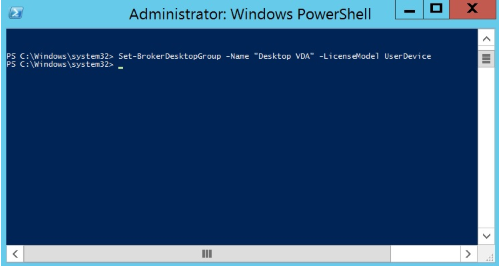
- 请通过运行以下命令来更改许可证产品:Set-BrokerDesktopGroup –Name “DeliveryGroupName” –ProductCode ProductCode。
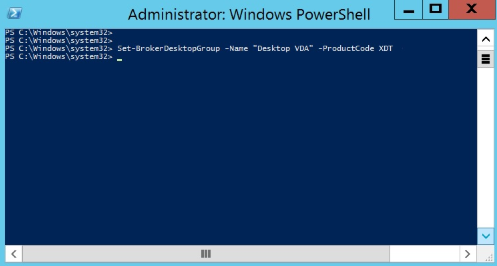
-
输入命令 Get-BrokerDesktopGroup –Name “DeliveryGroupName” 以验证所做的更改。
注意:
您不能混合和匹配同一站点中的版本。例如,Premium 和 Advanced 许可证。如果您拥有不同版本的许可证,则需要多个站点。

-
请运行之前步骤中所述的相同 Set-BrokerDesktopGroup 命令来删除许可证配置,并将值设置为 $null 。
注意:
Studio 不显示每个交付组的许可证配置。使用 PowerShell 查看当前配置。
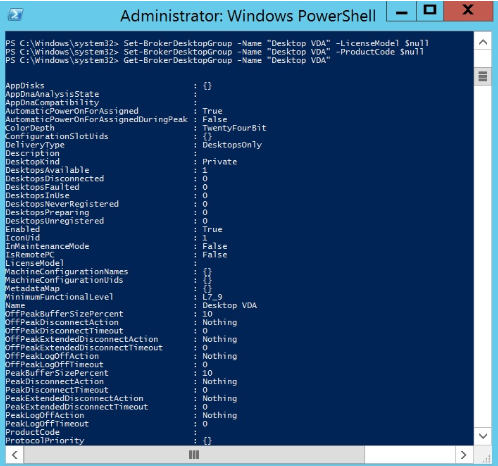
示例
此 PowerShell cmdlet 示例说明如何为两个现有交付组设置多类型许可,然后创建并设置第三个交付组。
要查看与交付组关联的许可产品和许可模式,请使用 Get-BrokerDesktopGroup PowerShell cmdlet。
-
为第一个交付组设置 XenApp 和 Concurrent。
Set-BrokerDesktopGroup -Name “Delivery group for Citrix Virtual Apps Premium Concurrent” -ProductCode MPS -LicenseModel Concurrent
-
为第二个交付组设置 XenDesktop 和 Concurrent。
Set-BrokerDesktopGroup -Name “Delivery group for Citrix Virtual Desktops Premium Concurrent” -ProductCode XDT -LicenseModel Concurrent
-
创建第三个交付组并为其设置 XenDesktop 和 UserDevice。
New-BrokerDesktopGroup -Name “Delivery group for Citrix Virtual Desktops Premium UserDevice” -PublishedName “MyDesktop” -DesktopKind Private -ProductCode XDT -LicenseModel UserDevice
共享
共享
This Preview product documentation is Citrix Confidential.
You agree to hold this documentation confidential pursuant to the terms of your Citrix Beta/Tech Preview Agreement.
The development, release and timing of any features or functionality described in the Preview documentation remains at our sole discretion and are subject to change without notice or consultation.
The documentation is for informational purposes only and is not a commitment, promise or legal obligation to deliver any material, code or functionality and should not be relied upon in making Citrix product purchase decisions.
If you do not agree, select I DO NOT AGREE to exit.